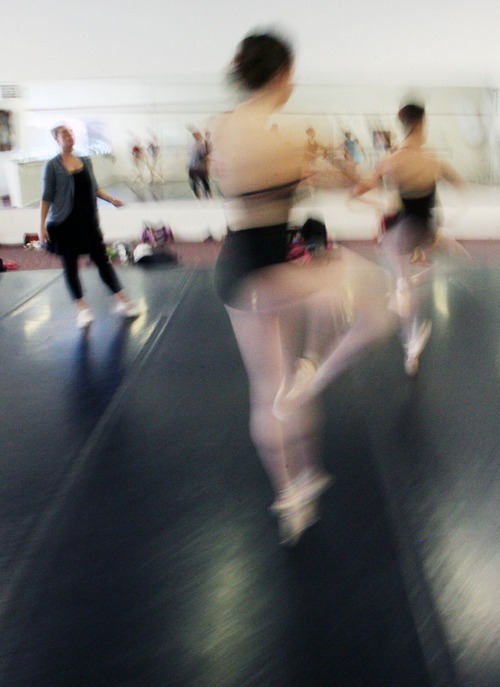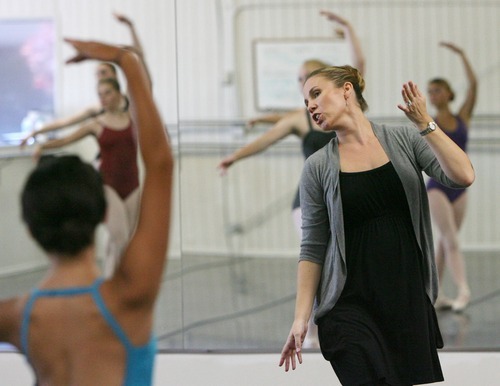This is an archived article that was published on sltrib.com in 2011, and information in the article may be outdated. It is provided only for personal research purposes and may not be reprinted.
Young Utah dancers who hope to pursue a professional career in ballet have several training options in Salt Lake City — most notably Ballet West Academy and most recently Salt Lake City Ballet Academy.
Yet there are also outstanding choices for those who live north and south of downtown. Through interviews with students, studio founders and the professional dancers who teach in those studios, we've chosen to highlight three programs.
Dance professionals agree faculty is the most important factor in choosing a good school, followed by a solid pedagogy, a suitable facility, appropriate performance experience, and balancing home and school life with ballet.
But don't just take our word for it. Here are what studio founders and teachers recommend, as well as some tips (see box) for selecting a dance program.
Classical Ballet Academy
Founded in 2004 by Jennie Creer-King; 875 S. 170 East, Provo; 801-377-4892; http://www.jenniecreerking.com
Jennie Creer-King • "Rather than keeping students, my goal is to train students out of the studio and into the profession. I create strong ties with university programs and dance professionals. My staff and I provide the best technical training we possibly can. And then I post audition fliers, teach them how to audition, offer help with university applications, submit summer program forms and encourage students to seek additional training and experience anywhere to help them become better dancers. Our studio philosophy is to guide students rather than fix them. We set a goal with the student, and students respond and discover the answers themselves."
Jessica Harston Thompson • Ballet West principal dancer, 1999-2004. "I love teaching at CBA because it is specifically a ballet school with students who want to learn classical ballet. I have such a passion for classical ballet, it makes sense to me, and I want to pass that on. Jennie has a wonderful way of combining the essence of the ballet traditions of discipline and respect with the American ideal that anyone has the opportunity to explore the art form. She prepares students for situations where they'll encounter criticism and rejection, but arms them with information about options and opportunities. I continue to grow personally and artistically, because Jennie brings in master teachers and provides workshops and seminars for the faculty. So, although my performing career is over, I'm continuing my dance education and getting to choreograph as well."
Jacqueline's School of Ballet
Founded in 1976 by Jacqueline Colledge; official school of Utah Regional Ballet; 493 N. 1020 West, Lindon; 801-796-7323, http://www.jacquelinesballet.com
Jacqueline Colledge • "A systematic syllabus prevents gaps in the student's training. Over the past 23 years, I've developed a solid, systematic training syllabus. I've been around long enough to see the results as students become professionals at every level. With a systemic approach, there are no holes in the technical training that need to be fixed later or become ingrained habits that can't be corrected. We require a lot, but the students get a lot in return."
Pamela Robinson-Harris • "Ballet West principal ballet mistress. "I have taught at Jackie's studio for nearly as long as I have been at Ballet West, which is currently 27 years. It is definitely a school for the serious ballet student who is disciplined and wants to work at a very high level. Jackie produces dancers who are well rounded, technically sound and very good performers."
Creative Arts Academy
Founded in 2004 by Jana Monson; 165 S. Main St., Bountiful; 801-295-3798, http://www.creativeartsacademy.net.
Jana Monson • "Qualified teachers are vital to a student's progress. If your time in class is productive, with highly qualified instructors who challenge you and make insightful and accurate corrections, you don't need to be in class an excessive amount of hours. A student can spend hours in class making the same mistake over and over and never progress. All of our teachers are either university trained or have worked for at least seven years as a paid professional. They understand the profession and the art form."
Kate Crews Linsley • Ballet West soloist for 10 years who retired earlier this year. "I continue to teach for Jana because of the positive atmosphere in the studio. The positive attitude translates to students taking artistic risks and responding to corrections quickly. In a positive atmosphere, students' minds are open and flexible and the improvement is more rapid and sustained. I even see students encouraging each other, which I love." —
Choosing a dance school
Ballet faculty • Professional stage experience doesn't guarantee a good teacher, but it helps with insight into the career path. Instructors should absolutely have strong ballet training and be able to articulate their approach.
A suitable facility • A sprung floor is very important in preventing injuries. Also check for supported barre, mirrors and a good sound system — or live accompanist.
Performance • Annual performances give students necessary stage experience, but the process is more important than a flashy product. Controversy surrounds combo-dance "competition studios." However, respected competitions such as the USA International Ballet Competition, Youth America Grand Prix and The World Ballet Competition provide exposure for students and valid performance experience.
Note • If you see hundreds of trophies piled in the neighborhood studio window, it represents little more than memorized "routines," glitzy costumes and travel expense.
Kathy Adams







